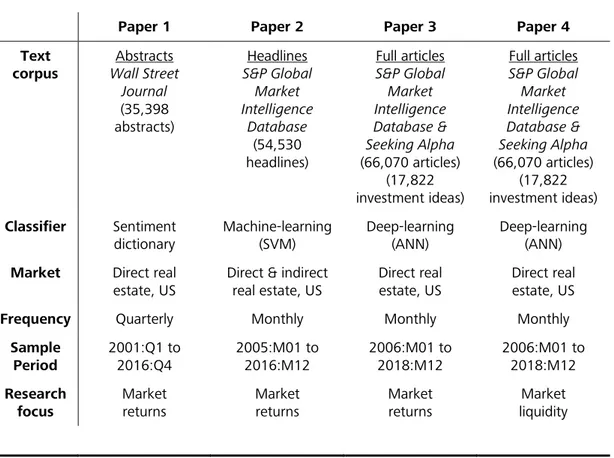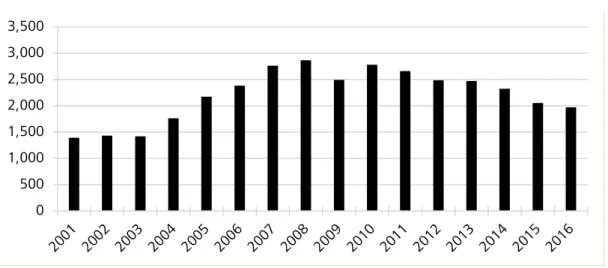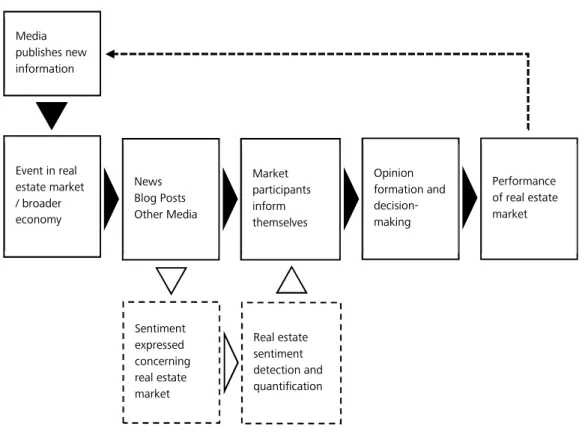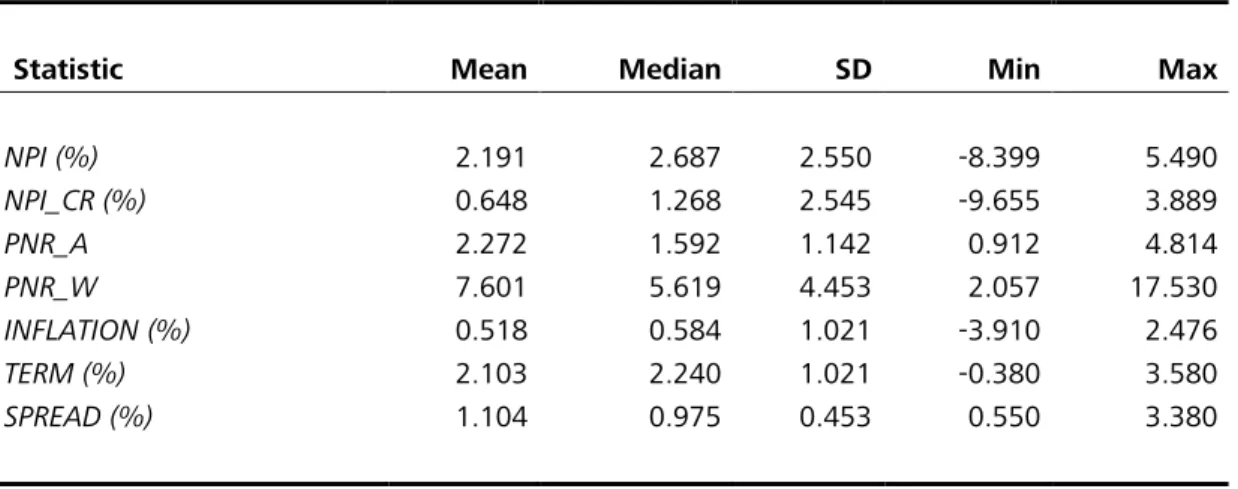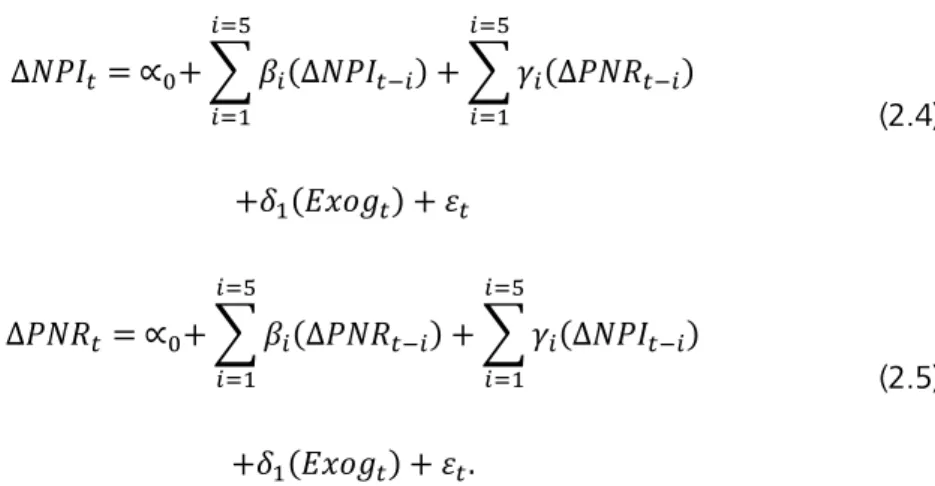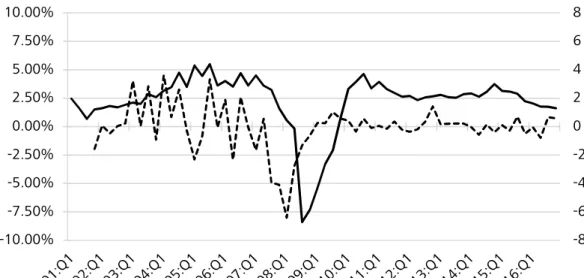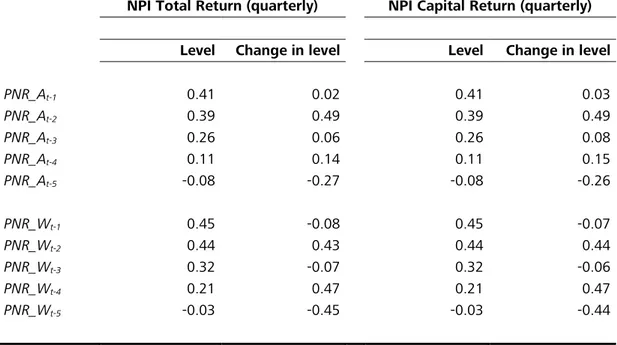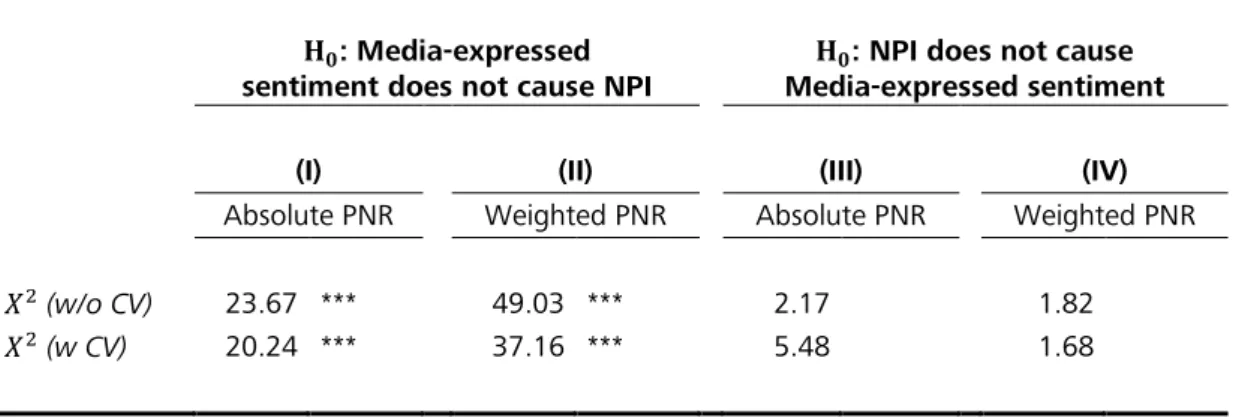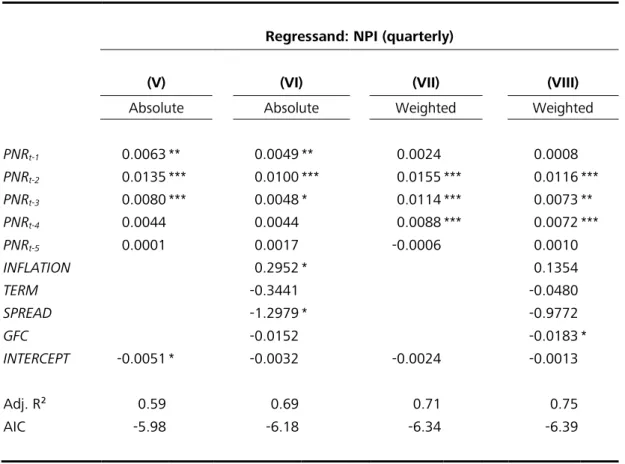Schriften
zu Immobilienökonomie und Immobilienrecht
Herausgeber:
IREIBS International Real Estate Business School
Prof. Dr. Sven Bienert
Prof. Dr. Stephan Bone-Winkel Prof. Dr. Kristof Dascher Prof. Dr. Dr. Herbert Grziwotz Prof. Dr. Tobias Just
Prof. Gabriel Lee, Ph. D.
Prof. Dr. Kurt Klein
Prof. Dr. Jürgen Kühling, LL.M.
Prof. Dr. Gerit Mannsen
Prof. Dr. Dr. h.c. Joachim Möller Prof. Dr. Karl-Werner Schulte HonRICS Prof. Dr. Wolfgang Schäfers
Prof. Dr. Steffen Sebastian Prof. Dr. Wolfgang Servatius Prof. Dr. Frank Stellmann Prof. Dr. Martin Wentz
Band 96
Jochen Hausler
Essays on the
Influence of Textual
Sentiment in Real
Estate Markets
Jochen Hausler
Essays on the Influence of Textual Sentiment in Real Estate Markets
Die Deutsche Bibliothek – CIP Einheitsaufnahme Jochen Hausler
Essays on the Influence of Textual Sentiment in Real Estate Markets Regensburg: Universitätsbibliothek Regensburg 2019
(Schriften zu Immobilienökonomie und Immobilienrecht; Bd. 96) Zugl.: Regensburg, Univ. Regensburg, Diss., 2019
978-3-88246-422-1
978-3-88246-422-1
© IRE|BS International Real Estate Business School, Universität Regensburg Verlag: Universitätsbibliothek Regensburg, Regensburg 2019
Zugleich: Dissertation zur Erlangung des Grades eines Doktors der Wirtschaftswissenschaften, ein- gereicht an der Fakultät für Wirtschaftswissenschaften der Universität Regensburg
Tag der mündlichen Prüfung: 27. November 2019 Berichterstatter: Prof. Dr. Wolfgang Schäfers
Prof. Dr. Stephan Bone-Winkel
Essays on the
Influence of Textual Sentiment
in Real Estate Markets
Table of Contents
Table of Contents ... V List of Tables ... IX List of Figures ... XI
1 Introduction ... 1
1.1 General Motivation and Theoretical Foundation ... 1
1.2 Research Questions ... 4
1.3 Submissions and Conference Presentations ... 6
1.4 References ... 9
2 On the Relationship between Market Sentiment and Commercial Real Estate Performance – A Textual Analysis Examination ... 11
2.1 Abstract ... 11
2.2 Introduction ... 12
2.3 Literature Review ... 13
2.3.1 Investors’ Sentiment and Commercial Real Estate ... 14
2.3.2 Sentiment Measure Using Textual Analysis ... 16
2.4 Data ... 17
2.4.1 News Data ... 17
2.4.2 Sentiment Measure Construction ... 18
2.4.3 Other Data ... 21
2.5 Methodology and Hypothesis Formation ... 23
2.5.1 Visual and Correlation Analysis ... 23
2.5.2 Regression Analysis ... 23
2.5.3 Vector Autoregressive Analysis ... 24
2.5.4 Granger Causality Tests ... 25
2.6 Results ... 26
2.6.1 Visual and Correlation Results ... 26
2.6.2 Regression Analysis Results ... 28
2.6.3 Vector Autoregressive Analysis Results ... 30
2.6.4 Granger Causality Test Results ... 32
2.7 Robustness Checks ... 33
2.8 Conclusion ... 37
2.9 Appendix ... 38
2.9.1 Creation of a Real-Estate Specific Dictionary ... 38
2.9.2 Text Pre-Processing ... 38
2.9.3 Quantifying News-Based Sentiment ... 39
2.9.4 Testing for Stationarity – Unit Root Test Results ... 41
2.9.5 VAR Results with Capital Appreciation Returns Only ... 42
2.10 References ... 44
3 News-Based Sentiment Analysis in Real Estate: A Machine-Learning Approach ... 48
3.1 Abstract ... 48
3.2 Introduction ... 49
3.3 Literature Review... 51
3.3.1 Sentiment Analysis and the Subcategory of Textual Analysis ... 51
3.3.2 Dominant Methodologies in Textual Analysis ... 52
3.3.3 Sentiment Analysis in the Context of Real Estate ... 53
3.4 Data ... 55
3.4.1 News Data ... 55
3.4.2 Real Estate Data ... 57
3.4.3 Further (Economic) Data ... 57
3.5 Methodology ... 61
3.5.1 Sentiment Extraction via Machine-Learning ... 61
3.5.2 Creating Real Estate Sentiment Measures ... 63
3.5.3 Vector Autoregression ... 65
3.6 Results ... 67
3.6.1 Securitized Real Estate Market ... 67
3.6.2 Direct Real Estate Market ... 72
3.6.3 Synopsis ... 78
3.7 Conclusion ... 80
3.8 References ... 82
4 On the Predictive Potential of Investor Sentiment: A Deep-Learning Approach ... 88
4.1 Abstract ... 88
4.2 Introduction ... 89
4.3 Literature Review... 91
4.3.1 Text-Based Sentiment Analysis in Finance ... 91
4.3.2 Sentiment Analysis in the Realm of Real Estate ... 92
4.4 Data ... 94
4.4.1 Seeking Alpha ... 94
4.4.2 S&P News Database ... 95
4.4.3 Direct Market Return and Macroeconomic Controls ... 96
4.5 Methodology ... 97
4.5.1 Artificial Neural Network ... 97
4.5.2 Econometric Approaches ... 103
4.6 Results ... 108
4.6.1 Linking Sentiment to Market Returns ... 109
4.6.2 Accounting for Market Regimes ... 113
4.6.3 Binary Return Forecasts ... 118
4.6.4 Synopsis ... 123
4.7 Conclusion ... 124
4.8 References ... 126
5 Artificial Intelligence, News Sentiment and Property Market Liquidity ... 133
5.1 Abstract ... 133
5.2 Introduction ... 134
5.3 Literature Review ... 135
5.4 Data and Methodology ... 137
5.4.1 Sentiment Index ... 138
5.4.2 Liquidity Proxies ... 141
5.4.3 Control Variables ... 143
5.5 Regression Analysis ... 144
5.6 Results ... 146
5.7 Conclusion ... 150
5.8 Appendix ... 151
5.9 References ... 154
6 Conclusion ... 157
6.1 Executive Summary ... 157
6.2 Final Remarks ... 161
6.3 References ... 163
List of Tables
Table 1.1: Course of Analysis ... 4
Table 2.1: Descriptive Statistics ... 22
Table 2.2: Correlations: Sentiment and NPI Total Returns... 28
Table 2.3: MLR Results: Quarterly NPI Returns and Media-Expressed Sentiment ... 29
Table 2.4: VAR Results: Quarterly NPI Returns and Media-Expressed Sentiment ... 31
Table 2.5: Granger Causality Test Results ... 32
Table 2.6: MLR Results: Quarterly Appreciation Returns and Media-Expressed ... Sentiment ... 33
Table 2.7: MLR Results: Sentiment in Accelerating vs. Slowing-Down Markets ... 35
Table 2.8: Calculating the PNR for Three Exemplary Abstracts A, B, C ... 40
Table 2.9: Unit Root Tests: Augmented Dickey-Fuller Test Results ... 41
Table 2.10: VAR Results: Quarterly Appreciation Returns and Media-Expressed ... Sentiment ... 42
Table 2.11: Granger Causality Test Results with Capital Returns ... 43
Table 3.1: Descriptive Statistics: Real Estate Returns and Economic Time Series ... 58
Table 3.2: Data Description ... 60
Table 3.3: Descriptive Statistics: News-Based Sentiment Measures ... 65
Table 3.4: VAR Estimation Results: News-Based Sentiment and Securitized Real ... Estate Market ... 68
Table 3.5: VAR Estimation Results: News-Based Sentiment and Securitized Real ... Estate Market – Controlling for Other Sentiment Indicators ... 70
Table 3.6: VAR Estimation Results: News-Based Sentiment and Direct Real Estate ... Market ... 73
Table 3.7: VAR Estimation Results: News-Based Sentiment and Direct Real Estate ... Market – Controlling for Other Sentiment Indicators ... 76
Table 4.1: Descriptive Statistics ... 96
Table 4.2: VAR Estimation Results... 109
Table 4.3: Markov-Switching Model Estimations ... 113
Table 4.4: VAR Estimation Results in Up- and Down-Market Periods ... 116
Table 4.5: Logit Estimation Results ... 119
Table 4.6: Forecast Performance... 121
Table 5.1: Descriptive Statistics ... 144 Table 5.2: Liquidity and Sentiment: Autoregressive Distributed Lag Models ... 146 Table 5.3: Liquidity and Sentiment: Autoregressive Distributed Lag Models with ...
Alternative Liquidity Measures ... 151
List of Figures
Figure 2.1: WSJ Real Estate News Coverage, 2001 – 2016 ... 18
Figure 2.2: News-Impact-Model ... 19
Figure 2.3: Commercial Real Estate Returns and Media-Expressed Sentiment ... 27
Figure 3.1: SNL Real Estate News Coverage, 2005 – 2016 ... 56
Figure 4.1: S&P News Distribution over Study Period ... 95
Figure 4.2: Basic Structure of an Artificial Neural Network ... 98
Figure 4.3: Temporal Progression of the SI... 102
Figure 4.4: Markov-Switching – Filtered Probabilities ... 115
Figure 4.5: In-Sample Probability Forecast for Market Return Directions ... 121
Figure 4.6: Out-of-Sample Forecasting Performance ... 123
Figure 5.1: ANN Layout ... 140
1.1 General Motivation and Theoretical Foundation
1 Introduction
1.1 General Motivation and Theoretical Foundation
The analysis of a potential influence of sentiment on asset markets in general and real estate markets in particular rests on two crucial assumptions, controversially discussed by scholars of behavioral finance and market efficiency supporters. The first assumption is that of investors subject to sentiment, which contrasts the standard finance model of unemotional and rational investors. Hereby, sentiment is commonly referred to as the existence of beliefs about cash flows and risks not explained by fundamentals (Baker and Wurgler, 2007). This assumption was pioneered for financial markets by Long et al. (1990) emphasizing that models incorporating „noise traders” in the spirit of Kyle (1985) and Black (1986) are able to explain financial anomalies. The second essential assumption is that of limited possibilities for arbitrage (Shleifer and Vishny, 1997). When betting against sentiment-driven investors is risky and costly, prices are prevented from being aggressively forced back to fundamentals by arbitrageurs (Baker and Wurgler, 2007).
Considering the primary case of application of these models are highly efficient stock markets, real estate as an “imperfect”, alternative asset class does not evidently provide a good fit. However, through its inherent imperfections, the nature of “real” assets abets these two aforementioned assumptions in property markets as well. Buildings are immobile, heterogeneous and of large investment volume, which leads to prolonged transaction periods and benefits local agents acting in segmented and informationally inefficient regional markets. Driven by asymmetric information between buyer and seller, sentiment-induced trading behavior is promoted. This notion is supported by findings of Gallimore and Gray (2002) which stress the high importance of investor sentiment in property investment decision-making. Yet these findings are not limited to transaction activities. With respect to property valuations in the UK, Crosby et al. (2010) also demonstrate the significant role of client influence on appraisal outcomes. Additionally,
1.1 General Motivation and Theoretical Foundation
mispricing. Correspondingly, Clayton et al. (2009) were able to provide evidence that investor sentiment also impacts commercial real estate pricing in the US.
With a growing body of literature on sentiment in finance and real estate markets, research focus gradually shifted away from the question of relative importance and existence of sentiment to the question of appropriate measurement of sentiment and the quantification of its influence. Textual sentiment analysis, i.e. the attempt to extract evaluations, attitudes and emotions from text corpora (Liu, 2012, preface), is in fact a more recent approach.
More traditional alternatives are surveys and market-based sentiment proxies such as NAV discounts, mortgage fund flows, property index transaction frequencies, past returns and buy-sell imbalances (see e.g. Lin et al., 2009; Clayton et al., 2009; Freybote and Seagraves, 2017).
Despite their frequent application in real estate research (see e.g. Clayton et al., 2009; Das et al., 2015; Freybote, 2016), surveys such as the Real Estate Research Corporation sentiment indicator are, by their very nature, associated with material disadvantages. They are time-consuming, costly and might also reflect false sentiment when survey participants are wrongly incentivized or do intentionally provide wrong answers. Additionally, due to their usually low frequency as well as time-lag bias, they are less useful for time series analysis. In contrast, market-based proxies are fundamentally incentivized as they proxy the behavior of market participants but also have respective drawbacks. Besides being highly dependent on the underlying theory, they might also ignore unperceived, but valuable factors of decision-making, which are not captured by mere quantitative market measures.
However, due to an increasing number of digital text documents, a rise in computational power and the development of new classification techniques, textual sentiment analysis gained more and more attention in more recent years. When using real estate related textual documents as “sentiment provider”, the measures are not only directly linked to the asset class but also allow for short and flexible sentiment aggregation periods. As the availability of text-based sentiment measures solely depends on the frequency of publication of the underlying text corpus, these indicators not only surpass many other sentiment measures with regard to actuality but also enable an investigation of whether news sentiment leads market movements or vice versa (see Tetlock, 2007 for an in-depth discussion of the lead-lag theory).
1.1 General Motivation and Theoretical Foundation Especially sentiment dictionaries allow for a straightforward and transparent application because of readily available software solutions (Kearney and Liu, 2014). However, in direct comparison, the performance of more technically advanced machine-learning approaches is usually higher (Li, 2010). Furthermore, artificial neural networks, as part of so-called deep-learning classifiers, have the potential to extract a much richer information structure from textual documents. With more and more data available for training, they provide a better scalability and are predestined for real time analytics and big data applications, which further deems them superior to traditional indicators.
In spite of these theoretical advantages, the potential of textual sentiment indicators in real estate has not been explored in practice. Although there is some related literature, studies such as Soo (2015) and Walker (2014) are – except of Ruscheinsky et al. (2018) – mostly limited to the housing market and rely on a dictionary-based approach. With respect to textual sentiment in real estate, machine- and deep-learning classifiers have been completely ignored. Accordingly, the following four studies bridge the gap and shed light on the potential of such textual sentiment indicators within the neglected area of commercial real estate. For the first time, the capabilities of a machine- and a deep-learning classifier for predicting direct and securitized market returns and liquidity within the US are assessed. Additionally, the relationship with up- and down-market periods, market regimes and out-of-sample forecasting performance are studied. Overall, this should answer the question whether real estate news analytics by means of textual sentiment classifiers in general and machine- and deep-learning algorithms in particular can be perceived as a valuable and innovative source of market sentiment and is able to provide researchers and practioneers with a reliable leading market indicator.
Accordingly, paper 1 kicks off the series with an attempt to predict private commercial real estate market returns by analyzing abstracts from the Wall Street Journal through the application of a sentiment dictionary. Subsequently, paper 2 refines the approach in several dimensions: The study is conducted on a monthly instead of quarterly basis, relies on a support vector machine (SVM) i.e. a machine-learning approach for sentiment classification and also includes the securitized real estate market in the United States. With paper 3 and paper 4, research delves into the sphere of deep-learning by facilitating an artificial neural network (ANN) for sentiment extraction. Accounting for different market regimes, the created indicator is once more related to market returns. Additionally, in- and out-of- sample forecasting performance in up- and down-market periods and the link to market
1.2 Research Questions
Table 1.1 highlights the main features of the four research studies. Subsequently, Section 1.2 elaborates the research questions examined. Section 1.3 provides an overview on submissions and conference presentations before Sections 2 to 5 present the studies in their entirety. Section 6 concludes and discusses limitations and future research opportunities.
Table 1.1: Course of Analysis
Paper 1 Paper 2 Paper 3 Paper 4
Text corpus
Abstracts Wall Street
Journal (35,398 abstracts)
Headlines S&P Global
Market Intelligence
Database (54,530 headlines)
Full articles S&P Global Market Intelligence Database &
Seeking Alpha (66,070 articles)
(17,822 investment ideas)
Full articles S&P Global Market Intelligence Database &
Seeking Alpha (66,070 articles)
(17,822 investment ideas) Classifier Sentiment
dictionary
Machine-learning (SVM)
Deep-learning (ANN)
Deep-learning (ANN) Market Direct real
estate, US
Direct & indirect real estate, US
Direct real estate, US
Direct real estate, US
Frequency Quarterly Monthly Monthly Monthly
Sample Period
2001:Q1 to 2016:Q4
2005:M01 to 2016:M12
2006:M01 to 2018:M12
2006:M01 to 2018:M12 Research
focus
Market returns
Market returns
Market returns
Market liquidity
1.2 Research Questions
While all four research articles revolve around the primary question of the influence of textual sentiment in real estate markets, each study concentrates on partial aspects which – at the end – are intended to condense to an overall picture. As initial research, paper 1 and 2 take advantage of a set of predefined hypotheses or research questions. However, paper 3 and paper 4 attempt to provide a more “out-of-the-box”-approach and explore the general nature of a deep-learning sentiment classifier with respect to market liquidity and returns. In more detail, the following aspects are addressed in the respective papers.
1.2 Research Questions Paper 1 | On the Relationship between Market Sentiment and Commercial
Real Estate Performance – A Textual Analysis Examination
Research question 1:
Does real estate market sentiment extracted by means of a sentiment dictionary predict future returns of the private commercial real estate market in the US?
Research question 2:
Is there evidence of a one- or of a bi-directional relationship? More formally, does media-expressed sentiment predict future returns of private commercial real estate, while returns on private commercial real estate do not predict future media- expressed sentiment?
Research question 3:
When considering appreciation instead of total returns, do results with respect to the influence of media-expressed sentiment still hold?
Research question 4:
Is sentiment-based predictability of total returns asymmetric i.e. is there higher predictability power during periods of slower market growth?
Paper 2 | News-Based Sentiment Analysis in Real Estate:
A Machine-Learning Approach
Research question 1:
Can sentiment measures created via machine-learning predict the securitized commercial real estate market?
Research question 2:
Is the predictive power different for the direct real estate market?
Research question 3:
How do the created sentiment indicators perform in addition to established sentiment measures?
Research question 4:
Is there evidence that market participants react differently to negative news in
1.3 Submissions and Conference Presentations
Paper 3 | On the Predictive Potential of Investor Sentiment:
A Deep-Learning Approach
Research question 1:
Is textual sentiment extracted from news articles with the help of an artificial neural network able to explain direct real estate market returns?
Research question 2:
Is there any evidence of a non-linear relationship between sentiment and market returns? Should econometric models account for different market regimes?
Research question 3:
Does the sentiment indicator show some binary return forecast potential? Thus, is textual sentiment capable of forecasting up- and down-market periods?
Paper 4 | Artificial Intelligence, News Sentiment and Property Market Liquidity
Research question 1:
Do results provide any evidence of explanatory power of the sentiment indicator with respect to changes in market liquidity?
Research question 2:
Do results differ with respect to the depth, resilience and breadth dimensions of market liquidity? Hence, can one find evidence of Baker and Stein’s (2004) hypotheses of a negative relationship between sentiment and price impact as well as of a positive relationship of sentiment and trading volume?
Research question 3:
Do results still hold when using other measures of market liquidity as alternatives to Amihud’s (2002) price impact measure as well as transaction volume?
1.3 Submissions and Conference Presentations
While the main purpose and study design of the four presented research articles has been highlighted in Sections 1.1 and 1.2, Section 1.3 complements the previous sections with details regarding submission to journals, publication status and conference presentations.
1.3 Submissions and Conference Presentations Paper 1 | On the Relationship between Market Sentiment and Commercial
Real Estate Performance – A Textual Analysis Examination Authors:
Eli Beracha, Jochen Hausler and Marcel Lang Submission:
Journal: Journal of Real Estate Research Submission date: 04/02/2018
Current Status: Accepted (11/30/2018) Conference presentations:
The paper was presented at the 34th Annual Conference of the American Real Estate Society (ARES) in Bonita Springs, US.
Paper 2 | News-Based Sentiment Analysis in Real Estate:
A Machine-Learning Approach Authors:
Jochen Hausler, Jessica Ruscheinsky, Marcel Lang Submission:
Journal: Journal of Property Research Submission date: 03/15/2018
Current Status: Accepted (11/19/2018) Conference presentations:
In 2018, this paper was presented at the 24th Annual Conference of the European Real Estate Society (ERES) in Delft, Netherlands as well as at the 34th Annual Conference of the American Real Estate Society (ARES) in Bonita Springs, US. Furthermore, the published version was presented at the 35th Annual Conference of the American Real Estate Society (ARES) in Paradise Valley, US.
1.3 Submissions and Conference Presentations
Paper 3 | On the Predictive Potential of Investor Sentiment:
A Deep-Learning Approach Authors:
Jochen Hausler, Johannes Braun, Wolfgang Schäfers Submission:
Journal: Journal of Real Estate Research Submission date: 08/08/2019
Current Status: Under review Conference presentations:
In 2019, this paper was presented at the 35th Annual Conference of the American Real Estate Society (ARES) in Paradise Valley, US as well as the 24th Asian Real Estate Society (AsRES) International Conference, Shenzhen, China.
Paper 4 | Artificial Intelligence, News Sentiment and Property Market Liquidity
Authors:
Johannes Braun, Jochen Hausler, Wolfgang Schäfers Submission:
Journal: Journal of Property Investment & Finance Submission date: 08/01/2019
Current Status: Under review
1.4 References
1.4 References
Amihud, Y. (2002), “Illiquidity and Stock Returns: Cross-Section and Time-Series Effects”, Journal of Financial Markets, Vol. 5 No. 1, pp. 31–56.
Baker, M. and Wurgler, J. (2007), “Investor Sentiment in the Stock Market”, Journal of Economic Perspectives, Vol. 21 No. 2, pp. 129–152.
Black, F. (1986), “Noise”, The Journal of Finance, Vol. 41 No. 3, pp. 528–543.
Clayton, J., Ling, D. C. and Naranjo, A. (2009), “Commercial Real Estate Valuation:
Fundamentals Versus Investor Sentiment”, Journal of Real Estate Finance and Economics, Vol. 38 No. 1, pp. 5–37.
Crosby, N., Lizieri, C. and McAllister, P. (2010), “Means, Motive and Opportunity?
Disentangling Client Influence on Performance Measurement Appraisals”, Journal of Property Research, Vol. 27 No. 2, pp. 181–201.
Das, P. K., Freybote, J. and Marcato, G. (2015), “An Investigation into Sentiment- Induced Institutional Trading Behavior and Asset Pricing in the REIT Market”, The Journal of Real Estate Finance and Economics, Vol. 51 No. 2, pp. 160–189.
Freybote, J. (2016), “Real Estate Sentiment as Information for REIT Bond Pricing”, Journal of Property Research, Vol. 33 No. 1, pp. 18–36.
Freybote, J. and Seagraves, P. A. (2017), “Heterogeneous Investor Sentiment and Institutional Real Estate Investments”, Real Estate Economics, Vol. 45 No. 1, pp. 154–
176.
Gallimore, P. and Gray, A. (2002), “The Role of Investor Sentiment in Property Investment Decisions”, Journal of Property Research, Vol. 19 No. 2, pp. 111–120.
Kearney, C. and Liu, S. (2014), “Textual Sentiment in Finance: A Survey of Methods and Models”, International Review of Financial Analysis, Vol. 33, pp. 171–185.
Kyle, A. S. (1985), “Continuous Auctions and Insider Trading”, Econometrica, Vol. 53 No. 6, p. 1315.
1.4 References
Li, F. (2010), “The Information Content of Forward-Looking Statements in Corporate Filings-A Naïve Bayesian Machine Learning Approach”, Journal of Accounting Research, Vol. 48 No. 5, pp. 1049–1102.
Lin, C. Y., Rahman, H. and Yung, K. (2009), “Investor Sentiment and REIT Returns”, The Journal of Real Estate Finance and Economics, Vol. 39 No. 4, pp. 450–471.
Liu, B. (2012), Sentiment Analysis and Opinion Mining, Synthesis lectures on human language technologies, #16, Morgan & Claypool Publishers, San Rafael.
Long, J. B. de, Shleifer, A., Summers, L. H. and Waldmann, R. J. (1990), “Noise Trader Risk in Financial Markets”, Journal of Political Economy, Vol. 98 No. 4, pp.
703–738.
Ruscheinsky, J. R., Lang, M. and Schäfers, W. (2018), “Real Estate Media Sentiment through Textual Analysis”, Journal of Property Investment & Finance, Vol. 36 No. 5, pp. 410–428.
Shleifer, A. and Vishny, R. W. (1997), “The Limits of Arbitrage”, The Journal of Finance, Vol. 52 No. 1, pp. 35–55.
Soo, C. K. (2015), “Quantifying Animal Spirits: News Media and Sentiment in the Housing Market”, Ross School of Business Working Paper No. 1200, Stephen M. Ross School of Business, University of Michigan, 2015.
Tetlock, P. C. (2007), “Giving Content to Investor Sentiment: The Role of Media in the Stock Market”, The Journal of Finance, Vol. 62 No. 3, pp. 1139–1168.
Walker, C. B. (2014), “Housing Booms and Media Coverage”, Applied Economics, Vol. 46 No. 32, pp. 3954–3967.
2.1 Abstract
2 On the Relationship between Market Sentiment and Commercial Real Estate Performance – A Textual Analysis
Examination
2.1 Abstract
We examine whether and the extent to which news-based sentiment, captured by textual analysis, can predict the performance of the private commercial real estate market in the United States. Our results show that sentiment reflected in news abstracts of the Wall Street Journal predicts returns of commercial real estate up to four quarters in advance.
These findings are statistically significant and persist even when controlling for other related factors. This suggests that news-based sentiment can serve as an early market indicator. This paper is the first to examine the bi-directional relationship between sentiment, measured by textual analysis, and the performance of the private US commercial real estate market. The findings presented in this paper not only contribute to the academic literature, but also carry practical implications for real estate professionals.
Keywords: Sentiment, Textual Analysis, News analytics, Forecasting, Commercial Real Estate
2.2 Introduction
2.2 Introduction
Empirical evidence by Baker and Wurgler (2007) as well as Seiler et al. (2012b) suggests that real estate investors bear not only economic, but also emotional factors in mind when making real estate investment decisions. A variety of other studies also show that economic fundamentals do not account for all observed price changes in commercial or residential real estate markets and much of the expectations about future cash flow are tied to information that is related to other factors (e.g. see Shiller, 2007; Lin et al., 2009; Ling et al., 2014). That said, only limited academic research directly investigates the role of sentiment in the commercial real estate (CRE) markets. In this study, we look to address this underexplored topic and examine the bi-directional relationship between sentiment and market returns of the private CRE in the US. We do so by analyzing real estate sentiment gathered from news data of a leading financial newspaper in the US, which is a new source of sentiment to be used for this type of analysis.
The private CRE suffers from several obvious market inefficiencies. Compared with the securitized real estate markets, the transparency of the private CRE market is limited, causing asymmetric information situations to be more frequent. All else equal, asymmetric information leads to high information and transaction costs, which results in a less efficient market, overall. The heterogeneity of properties provides additional challenges to real estate appraisers and lengthens investors’ decision-making and transaction processes.
Therefore, it is reasonable to expect that investors and appraisers in private CRE market are especially vulnerable to the influence of sentiments and opinions expressed in the news items that they consume. The tendency of the private CRE to adjust slower to new information and its vulnerability to non-economic fundamentals makes it particularly worth examining under the light of textual sentiment analysis.
In this study we gather more than 35,000 real-estate related news articles from The Wall Street Journal (WSJ), spanning the 2001 through 2016 time period, and analyze them in order to detect real-estate related sentiment. Specifically, a dictionary-based textual analysis approach is used to quantify the level of optimism and pessimism expressed through the abstracts of these articles. The intertemporal links between this sentiment and the private CRE market over the 16-year sample period are then examined to determine whether media-expressed real estate sentiment can help predict private CRE returns.
Our findings indeed suggest that sentiment reflected in news articles can help predict returns on the private CRE market in the US even after controlling for other macroeconomic
2.3 Literature Review factors. On average, our measure for media-expressed sentiment leads total returns on private CRE properties up to four quarters. Additionally, we do not find evidence for a feedback loop, where information on the performance of private CRE is reflected in future media-expressed sentiment although this could be expected.
Following prospect theory (see e.g. Kahneman and Tversky, 1979; Tversky and Kahneman, 1991), which advocates the maximization of an S-shaped value function by market participants and therefore loss aversion as a stable preference1 – we further investigate the relevance of text-based sentiment measures during decelerating and accelerating market phases by splitting the sample accordingly. The results indeed show a higher relevance of sentiment indicators when markets are slowing down, which is consistent with previous findings in literature.
This study contributes to the existing literature by being the first to employ a real estate specific word dictionary to construct a real estate sentiment measure and determine whether and the extent to which such measure can help predict private CRE returns. More broadly, the results reported in this paper can be generalized to other less efficient investment asset classes.
The rest of this paper is organized as follows. In Section 2.3 we discuss the importance of sentiment in CRE markets and review relevant literature on investors’ sentiment and textual analysis in the realm of real estate research. Section 2.4 presents the data set employed in this paper as well as a description of the sentiment-extraction procedure. In Section 2.5 we detail the methodology used for the analysis and present the hypotheses. Sections 2.6 and 2.7 reports the results and assess their robustness, while Section 2.8 concludes and discusses the implications of the findings.
2.3 Literature Review
This study relates to two separate streams of literature. The first stream is the role of investors’ sentiment with respect to the commercial real estate markets and its performance. The second stream refers to the textual analysis methodology used in this
1 Bokhari and Geltner (2011) provide an excellent discussion of prospect theory, its three essential features –
2.3 Literature Review
paper and the most recent developments in text-based sentiment measures in the realm of real estate.
2.3.1 Investors’ Sentiment and Commercial Real Estate
Investors’ sentiment is often measured directly or indirectly using two types of proxies. The most common direct measure approach is survey-based, such as the Real Estate Research Corporation sentiment measure that is employed in a few recent studies (Clayton et al., 2009; Das et al., 2015b; Freybote, 2016). While claiming to capture investors’ sentiment directly, survey-based indicators, by their very nature, are associated with several material disadvantages. The surveys are not only costly and time consuming, but are also subject to the possibility that the answers provided by the respondents do not reflect their true sentiment. This might be due to the fact that respondents are not incentivized to take the surveys seriously or intentionally do not provide accurate and honest answers.
Indirect sentiment measures do not usually suffer from the disadvantages associated with the direct measures, because they are proxied by the actual behavior of market participants, which is fundamentally incentivized. These measures include, for example, closed-end fund discounts (Barkham and Ward, 1999; Clayton and MacKinnon, 2003; Lin et al., 2009), buy-sell-imbalances (Freybote and Seagraves, 2017), mortgage fund flows (Clayton et al., 2009; Ling et al., 2014), search engine volumes and trends (Beracha and Wintoki, 2013; Das et al., 2015a).
While many studies have examined the role of sentiment with relation to the residential real estate market, only a few studies have sought to investigate how investors’ sentiment is related to the performance of private CRE. At least five recent studies that identify the relationship between sentiment and CRE performance in the US are closely related to this study. Clayton et al. (2009) analyze the impact of fundamentals and their sentiment index – constructed from sentiment-related proxies – on CRE values over the 1997-2007 period.
Their results suggest that investors’ sentiment does play a role in CRE pricing at the national as well as MSA-level and is robust to relevant macroeconomic factors. Ling et al. (2009) investigate the role of capital flows and turnover rates on returns of the UK private CRE market in the United Kingdom. Using a panel VAR approach, they do not find evidence for
“price pressure” effects on capital flows, but for an information effect on turnover rates.
Although not directly facilitating sentiment measures, the examined causal relationships (return chasing, joint dependency and information cascades) can be interpreted as expressions of investor sentiment, making the study worthwhile in a real estate sentiment context. Similarly, Ling et al. (2014) examined the relationship between investor sentiment
2.3 Literature Review – measured via direct and indirect real estate sentiment measures – and private as well as public CRE market returns over the 1992-2009 period. Using VAR models, the authors provide evidence for a positive relation between investor sentiment and private market performance in subsequent quarters. However, the relationship between investor sentiment and public real estate market returns in subsequent periods was negative. The authors support their findings with the argument that, in the short term, sentiment drives prices away from fundamentals, i.e. causes sentiment-induced mispricing. Furthermore, assessing various survey-based sentiment measures, their study concludes that real-estate- specific sentiment measures are of high importance, when quantifying the influence of sentiment on real estate. Another related study is by Tsolacos et al. (2014). Their paper deploys a probit and Markov-switching model to predict rental growth in CRE and apartment rent series in the US. The authors illustrate the prediction power of several sentiment-based leading indicators on commercial rent price movements. Finally, Marcato and Nanda (2016) assess whether survey-based sentiment indices help predict changes in quarterly US commercial and residential real estate returns. Using a VAR approach, their findings suggest significant effects of sentiment on the residential, but not the CRE, market over the period 1988-2010. Moreover, their results reveal that real estate specific sentiment indicators are more suited in explaining real estate markets than general business indicators.
Each of the above-mentioned studies contributes to our knowledge on investors’
sentiment and CRE performance, but is also associated with its respective drawbacks.
Specifically, these studies ignore the impact of other unperceived, but valuable, factors on investors’ decision-making processes. For example, Price et al. (2017) show that executive emotions during earnings conference calls are positively related to investors’ initial reactions. Analyzing the vocal cues of managers with a voice analysis software revealed that investors do indeed react to this emotionally charged information. Similarly, professional news outlets publish daily thousands of news articles on the real estate market. These publications range from reports and opinions to views and perspectives and are likely to, consciously or unconsciously, influence investors’ action and, by extension, CRE performance.
In this study, we exploit this valuable source of information by applying textual analysis to published real estate news articles. This approach has already been applied in mainstream finance, but should be even more relevant to the private CRE market, which is arguably
2.3 Literature Review
2.3.2 Sentiment Measure Using Textual Analysis
In the finance literature, Tetlock (2007) is regarded as one of the pioneers in applying textual analysis in order to capture market sentiment. Tetlock employs a sentiment dictionary on the “Abreast of the Market” column of the Wall Street Journal and successfully shows a relationship between pessimism reflected in news items and price changes of the Dow Jones Industrial Average Index, as well as its trading volume. A few other studies followed with a similar methodology and facilitated dictionary-based approaches using sentiment-annotated word-lists in order to extract sentiment from news items (see, for example, Henry and Leone, 2016; Feldman et al., 2010; Davis et al., 2012).
While Tetlock (2007) use the Harvard GI word list from the field of psychology, Loughran and McDonald (2011) set a further cornerstone by highlighting the importance of a domain-specific dictionary. The authors develop a dictionary relevant to financial text corpora, which Boudoukh et al. (2013) and Heston and Sinha (2016) successfully utilize in their research.
Recently, a few studies examine the impact of sentiment extracted from text corpora in the context of real estate. Soo (2015) investigates the sentiment expressed in 37,500 local housing news articles of 34 US cities in order to predict future house prices. The author finds that the measured sentiment has predictability power and leads housing price movements by more than two years. Walker (2014) illustrates a material positive relationship between newspaper articles in the Financial Times and returns of listed companies engaged in the UK housing market. In accordance with his earlier findings, Walker (2016) subsequently analyzes the private housing market in the UK, and ascertains that news media granger-caused real house price changes from 1993 to 2008.
This paper aims to fill a gap in the literature and examines the relationship between textual based sentiment and the performance of private CRE in the US rather than the housing market or foreign publicly traded real estate firms. Investigating sentiment in the context of the private CRE market, which is expected to be less efficient than the public market, provides a meaningful contribution to the literature and the results can be generalized to other less efficient markets.
2.4 Data
2.4 Data
The dataset complied for the empirical analysis conducted in this study is based on three main sources: (1) a news media corpus to extract sentiment, (2) a measure of private US commercial real estate market performance and (3) general macroeconomic factors.
2.4.1 News Data
Our news data source used for the analysis in this study is The Wall Street Journal (WSJ).
Founded in New York City in 1889, the WSJ is nowadays the largest newspaper in the US in terms of its daily circulation.2 Nationally and internationally, the WSJ is considered by many as one of the leading sources of business and financial news and it includes a dedicated real estate section. The WSJ has a broad readership, ranging from retail to institutional investors as well as managers and real estate professionals. Given its corporate news, political and economic reporting as well as its financial and real estate market coverage, the WSJ is of great importance to the CRE market. Although Tetlock (2007) pioneered textual analysis based on the “Abreast of the Market” column of the WSJ in mainstream finance, the real estate literature still lacks an attempt to capture its sentiment.
Considering the aforementioned aspects, we use news items from the WSJ to capture and quantify media-expressed sentiment concerning the private CRE market. Specifically, via ProQuest (www.proquest.com), we accessed WSJ’s digital archive of the period that spans January 2001 until December 2016 and retrieved articles containing either the keywords
“real estate” or “REIT”. This 16-year period is a representative and worthwhile time span as it contains the real estate boom market phase until 2007, the real estate bust and the global financial crisis (GFC) from 2007 to 2010, as well as the subsequent recovery market phase from 2011. We further limited the data queries geographically to the US and to news reported in the English language. Over the sample period, the WSJ published 35,398 unique real estate-related news, which – on average – translates to more than 550 news items per calendar quarter. It is worth mentioning, that we exclusively analyze the abstracts of the newspaper articles. We assume, that these abstracts contain all relevant information of the articles themselves, but exclude noise in terms of irrelevant words and additional information, which are not necessary in order to capture the “tone” or sentiment expressed.
2.4 Data
Figure 2.1 shows the annual number of real estate-related news published by the WSJ over the sample’s 16-year time period that spans 2001 to 2016. The graph depicts a significant increase in news coverage during the boom market phase starting with around 1,759 news in 2004 and ending with 2,762 articles in 2007. During the real estate bust period, the number of articles reached its peak with 2,863 news items released in 2008 and then gradually declined. 1,970 news items were included in 2016, which is slightly above the average number of articles during the pre-crisis period. This general increase in real estate news coverage may suggests an overall rise of attention for real estate as an asset class.
Figure 2.1: WSJ Real Estate News Coverage, 2001 – 2016
Notes: Figure 2.1 plots the sample distribution with respect to the number of real-estate related news published by the WSJ per annum. All WSJ news were retrieved using ProQuest; all articles contain either the keyword “real estate” or “REIT”. The sample period is 2001:Q1 to 2016:Q4
2.4.2 Sentiment Measure Construction
To illustrate the theoretical background of our sentiment extraction procedure, we refer to the News-Impact-Model (Figure 2.2) of Lang (2018, p. 2). Accordingly, different news outlets report on certain events in the broader economy or on real estate markets. We assume that when real estate investors and appraisers inform themselves, the news to which they are exposed to – consciously or unconsciously – affect their opinion-formation and decision-making processes. Hence, the news-based sentiment is assumed to affect their individual sentiment. Thus, market participants’ actions in aggregation are based on certain expectations and are in turn able to influence the performance of the commercial real estate markets. Consequently, from a total return perspective, we expect news-based sentiment to affect the appreciation returns since real estate investors and appraisers adjust their willingness to pay and valuations, respectively, upon their expectations and
0 500 1,000 1,500 2,000 2,500 3,000 3,500
2.4 Data beliefs of future market developments.3 Ultimately, the resulting events and market performance might be newsworthy and reported on again. Accordingly, this research paper yields to detect and quantify the sentiment expressed in real estate news abstracts published by the WSJ.
Figure 2.2: News-Impact-Model
Based on this idea, we use a dictionary-based sentiment classifier to extract the sentiment from news abstracts, which could influence market participants during their opinion- formation and decision-making processes. Hence, we employ a pre-defined sentiment dictionary i.e. a word list annotated by sentiments such as positive or negative to every single news item and aggregate the sentiment of the identified words. This allows us to measure the overall “tone” of the abstracts.
Following Loughran and McDonald (2011) we apply a domain-specific dictionary by extending their pure finance dictionary to real estate specific terms. Our word list contains 408 positive and 2,455 negative terms. To ease the process of sentiment extraction, words
Event in real estate market / broader economy
News Blog Posts Other Media
Market participants inform themselves
Opinion formation and decision- making
Performance of real estate market
Real estate sentiment detection and quantification Media
publishes new information
Sentiment expressed concerning real estate market
2.4 Data
in the dictionary and in the news abstracts are preprocessed, i.e. converted in well-defined sequences of linguistically meaningful units following Uysal and Gunal (2014).4
For every abstract, we count positive and negative words. Hereby, each positive word is counted as a “+1” and each negative word as a “-1”. Because the sentiment dictionary does not consist of an equal number of positive and negative words, positive scores are multiplied by the inverse of the total number of positive terms divided by the total number of negative words in the dictionary. This calibrates the likelihood of that positive and negative words have similar impact on total count. This procedure allows us to calculate the overall sentiment score of each abstract by addition of the numeric values from the positive and negative words. An abstract can be viewed as positive, if the sentiment score is greater than 0, negative if the sentiment score is smaller than 0, and neutral if it is 0.
Subsequently, all positive, negative and neutral abstracts are added up for a defined period in order to arrive with a total periodic score of the positive, negative and neutral categories, respectively. This value is calculated on an absolute or weighted basis. The absolute basis only considers the raw number of positive and negative news items. For example, if there are 56 positive abstracts published during a given period, the positive periodic score for that period would simply be 56. On the other hand, the weighted approach uses the actual sentiment scores assigned to every abstract. This means that two negative abstracts with a score of “-5” and “-2” are added up for a score of “-7”.
This periodical aggregation of sentiment scores further allows us to generate a final combined sentiment measure for each period by calculating a so-called Positive-Negative- Ratio (PNR). This ratio expresses the amount of positive sentiment relative to total amount of negative sentiment. A higher ratio suggests a more positive sentiment and a lower ratio suggests a more negative sentiment with respect to the commercial real estate market.
More formally, the PNR is calculated as the following:
= ∑ ,
| ∑ , |, (2.1)
where i and j represent the abstracts with positive and negative scores, respectively, and t is the time period during which the published abstracts are accounted for. Because the category scores are measured either on an absolute or weighted basis so are the PNR-
4 For more details on this process please see sections 2.9.1 and 2.9.2.
2.4 Data ratios.5 For further details and a numeric example of the overall PNR calculation process, please refer to the “Quantifying News-Based Sentiment” of the appendix (Section 2.9.3).
While some scholars such as Ling et al. (2014) or Marcato and Nanda (2016) orthogonalize their sentiment proxies against a set of macroeconomic controls, others such as Freybote and Seagraves (2017) and Das et al. (2015b) do not. As dictionary-based approaches solely rely on opinionated word lists to proxy sentiment, one could argue that orthogonalizing is not as important as it would be for survey-based measures. However, it can also be stated that every sentiment indicator as a proxy of market perception should most likely be influenced by facts and sentiment at the same time and that this should be accounted for.
Therefore, the fact that we do not orthogonalize our sentiment measure can be interpreted as a possible shortcoming of this study and should be a subject of future research.
2.4.3 Other Data
The data on the performance of the private CRE market in the US used in this paper is the NPI series extracted from the National Council of Real Estate Investment Fiduciaries (NCREIF). The NPI is an unleveraged total return index for private CRE properties held by contributing institutional investors. Published with quarterly frequency since 1977, the NPI is an appraisal-based index where each property’s performance is weighted by its market value. Though it is available for different property types, we use the national composite NPI to measure total returns of the private US CRE market, incorporating the major property types i.e. apartments, hotels, industrial, office and retail. For our analysis, we are using total returns as well as capital-appreciation returns only as we expect news-based sentiment to especially affect appreciation returns.
In order to control for economic factors that are likely to affect CRE returns, we follow Clayton et al. (2009) and Ling et al. (2014) and include in our dataset macroeconomic variables proven to affect CRE returns. These variables include: the term structure of interest rates (defined as the spread between the ten-year US Treasury Constant Maturity rate and the 3-Month Treasury Bill yield), the percentage change in the Consumer Price Index (CPI) and the spread between Baa- and Aaa-rated corporate bonds yields. We obtain
5 While we acknowledge that there is heterogeneity across locations, especially in the United States, we assume that institutional investors and decision-makers act from a portfolio-perspective. Thus, we deem one overall-
2.4 Data
these economic variables from the Federal Reserve Bank of St. Louis with quarterly frequency.
Table 2.1 provides descriptive statistics about the quarterly NPI total returns (NPI), quarterly NPI capital-appreciation returns (NPI_CR), absolute and weighted Positive-Negative-Ratios (PNR_A and PNR_W) and our macroeconomic control variables. For each variable, we report the mean, median, standard deviation (SD), minimum (Min) and maximum (Max).
The average quarterly total returns of the private CRE during our sample period is 2.19%
and ranges between -8.40% and 5.49%, given the high volatility during the boom and bust phases that are part of our sample period. Capital-appreciation returns are associated
with lower quarterly values, ranging between
-9.66% and 3.89% with a mean (median) of 0.65% (1.27%). The average PNR_W value (7.60) is more than three times of the PNR_A value (2.27), which depicts the importance of distinguishing between the two measures and sheds light on the strength of the respective sentiment. The average quarterly INFLATION during the sample period was 0.52%, while TERM and SPREAD float around 1.1% and 2.1%, on average.
Table 2.1: Descriptive Statistics
Statistic Mean Median SD Min Max
NPI (%) 2.191 2.687 2.550 -8.399 5.490
NPI_CR (%) 0.648 1.268 2.545 -9.655 3.889
PNR_A 2.272 1.592 1.142 0.912 4.814
PNR_W 7.601 5.619 4.453 2.057 17.530
INFLATION (%) 0.518 0.584 1.021 -3.910 2.476
TERM (%) 2.103 2.240 1.021 -0.380 3.580
SPREAD (%) 1.104 0.975 0.453 0.550 3.380
Notes: Table 2.1 reports summary statistics of variables used in the analysis on a quarterly basis. NPI is the total return of the NPI and NPI_CR is the capital appreciation return. PNR_A and PNR_W are the absolute and weighted Positive-Negative-Ratio sentiment measures, respectively. INFLATION is the percentage change of the Consumer Price Index (CPI). TERM is the spread between the ten-year US Treasury Bond and the 3-Month Treasury Bill yields. SPREAD is the spread between Baa- and Aaa-rated corporate bonds yields. The sample period is 2001:Q1 to 2016:Q4.
2.5 Methodology and Hypothesis Formation
2.5 Methodology and Hypothesis Formation
2.5.1 Visual and Correlation Analysis
As our preliminary visual analysis, we plot the media-expressed sentiment measures against the returns of the private CRE market. Specifically, we plot the deviation of the sentiment measure from its 1-year moving average relative to the quarterly CRE total returns. This type of plot would illustrate the general relationship between changes in market sentiment and CRE returns and highlights whether market sentiment leads or lags returns.
Additionally, we calculate the respective correlations between our quarterly sentiment values and CRE quarterly returns.
2.5.2 Regression Analysis
We begin our empirical analysis by investigating the ability of real-estate related sentiment, expressed in the news, to predict total returns on the private CRE market in the US. To do so, we regress the NPI total return on the lagged absolute or weighted Positive-Negative- Ratios. By regressing CRE returns on our lagged media-expressed sentiment values, we test the hypothesis that market sentiment predicts future returns of the private CRE market.
Hypothesis 1: Real estate market sentiment predicts future returns of the private CRE market.
In addition to lagged media-expressed real estate sentiment, the regression specifications also control for other relevant macroeconomic variables proven to affect CRE market returns, (see e.g. Clayton et al., 2009 and Ling et al., 2014). Controlling for the term structure of interest rates is relevant because it is related to commercial real estate financing cost and expectations of future economic developments. Accounting for the percentage changes in the Consumer Price Index (CPI) is important because many commercial rental contracts are linked to inflation and therefore affect future returns. The spread between Baa- and Aaa-rated corporate bonds yields reflects the overall business conditions and general default risk in the economy. Finally, we include a dummy variable to control for any factors associated with the global financial crisis (GFC) from 2007:Q3 to 2008:Q4. Autocorrelation and heteroscedasticity issues are accounted for by using Newey and West (1987) robust standard errors.
2.5 Methodology and Hypothesis Formation Formally, we estimate the following equation:
∆ = + ∝ ∆ !"
#$
#
+ % ∆ &' " + %( ∆)* + "
+ %, ∆ *-. " + /&0 + 1 ,
(2.2)
where is the total return during quarter ; ! is the Positive-Negative-Ratio to measure media-expressed sentiment with quarterly lags; &' is the inflation rate, )* + the interest term ensure structure and *-. the spread between Baa- and Aaa-rated corporate bonds. /&0 is a dummy variable to indicate the global financial crisis and 1 represents the error term. Except of the crisis dummy, all variables are applied in first differences to stationarity.6
2.5.3 Vector Autoregressive Analysis
The multiple linear regression model described above estimates the value of the dependent variable (NPI) using several, supposedly independent, variables. However, it could be presumed that our media-expressed sentiment measures also contain information about past CRE market performance as indicated by the proposed News-Impact-Model of Section 2.4.2. Consequently, we examine the bi-directional relationship between media-expressed sentiment and the performance of the private US CRE market using a Vector Autoregressive (VAR) framework. According to this model, each variable is a linear function of lags of itself and lags of other variables. Hence, the VAR model allows us to estimate the intertemporal links between media-expressed sentiment and the private CRE market and address the potential endogeneity problem. Furthermore, the VAR model enables us to analyze whether the media-expressed sentiment predicts returns on private CRE, even when controlling for the lags of the NPI itself, which is shown to contain momentum (Beracha and Downs, 2015). Formally, the VAR model used in our analysis is specified as the following:
6 For results of the augmented Dickey-Fuller tests for the presence of unit roots, i.e. non-stationarity please refer to section 2.9.4 in the appendix.
2.5 Methodology and Hypothesis Formation
∆ = 2 3+ % ∆ !"
#$
#
+ 4 ∆ !"
#$
#
+ 5 ∆*6 " + 1
∆ = 2(3+ %( ∆ !"
#$
#
+ 4( ∆ !"
#$
#
+5( ∆*6 " + 1( .
(2.3)
The variables are as described above and defined in equation (2.2). Note that, for brevity, the control variables ( &' , )* + and *-. ) are summarized in *6 7. 1 and 1(
are the error terms. The endogenous variables are quarterly NPI returns ( !) and the media-expressed sentiment (PNR_A or PNR_W). We include lags up to t-5 based on the Akaike Information Criteria (AIC) for various choices of the lag length p. Applying the Augmented-Dickey-Fuller unit root test (see Dickey and Fuller, 1979; Said and Dickey, 1984) suggests using first differences of all variables to ensure stationarity.
2.5.4 Granger Causality Tests
We further examine the bi-directional relationship between media-expressed sentiment and CRE returns, by conducting pairwise Granger causality tests (Granger, 1969). This type of analysis helps us better understand the lead-lag relationships between sentiment in real estate related news and the private CRE market. We hypothesize that media-expressed sentiment drives total returns of the private CRE market, but not the other way around.
We base our hypothesis on evidence from the literature that the CRE market is not fully efficient and is slow to react to new market information. Formally, our hypothesis is stated as the following:
Hypothesis 2: Media-expressed sentiment predicts future returns of private commercial real estate, but returns on private commercial real estate do not predict future media- expressed sentiment.
Formally, the model for testing Granger causality between real estate market sentiment and returns is defined as follows:
2.6 Results
∆ = ∝3+ % ∆ ! "
#$
#
+ 4 ∆ !"
#$
#
+5 *6 " + 1
(2.4)
∆ = ∝3+ % ∆ !"
#$
#
+ 4 ∆ !"
#$
#
+5 *6 " + 1 .
(2.5)
The variables included in equations (2.4) and (2.5) are as described and defined earlier in the text. Consistent with our previous models, we conduct the tests for 1 to 5 lags and report the X² (Wald) statistics for the joint significance of each of the other lagged endogenous variables in both equations. The null hypothesis is that ΔPNR does not Granger-cause ΔNPI in equation (2.4) and vice versa in equation (2.5).
2.6 Results
2.6.1 Visual and Correlation Results
Figure 2.3 provides visual illustration of the relationship between our weighted media- expressed sentiment measure (PNR_W) and the returns on the private CRE market.8 A glance at the figure reveals that the two variables are correlated and that PNR_W seems to lead the private CRE market returns. For example, a substantial drop in sentiment occurred late 2007 and early 2008 and was followed by meaningful negative returns in the CRE market two quarters later. More specifically, the PNR_W drops from 0.54 in 2007:Q2 to -6.41 in 2008:Q1 and NPI total return bottomed in 2008:Q3 (-8.40%).
Similarly, the sentiment seems to also be a leading indicator in periods of recovery and expansion. Following the drop in real estate market sentiment the measure improved from 2008:Q1 to 2009:Q3 while returns on the private CRE market gradually recovered from 2008:Q3 to 2010:Q3 with most of the recovery taking place before 2010:Q1. That said, the relationship in pre-crisis years is less clear as the sentiment measures show a high level of fluctuation relative to the performance of the CRE market.
8 A figure using the absolute sentiment measure PNR_A was also conducted and appears qualitatively similar.
However, because the absolute measure only accounts for general optimism and pessimism in news abstracts, but not the respective magnitude, up and downs are less pronounced. This figure is omitted from this version of the paper for brevity.
